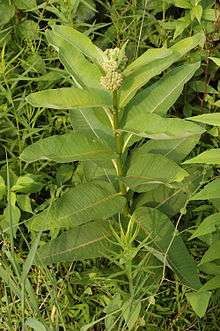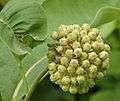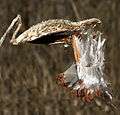Asclepias syriaca
Asclepias syriaca, commonly called common milkweed, butterfly flower, silkweed, silky swallow-wort, and Virginia silkweed, is a species of flowering plant. It is in the genus Asclepias, the milkweeds. This species is native to southern Canada and of much of the conterminous eastern U.S., east of the Rocky Mountains, excluding the drier parts of the prairies. It grows in sandy soils and other kinds of soils in sunny areas. It was one of the earliest North American species described in Jacques-Philippe Cornut's 1635 work Canadensium Plantarum Historia. The specific name was reused by Linnaeus due to Cornut's confusion with a species from Asia Minor.
| Asclepias syriaca | |
|---|---|
 | |
| Scientific classification | |
| Kingdom: | Plantae |
| Clade: | Tracheophytes |
| Clade: | Angiosperms |
| Clade: | Eudicots |
| Clade: | Asterids |
| Order: | Gentianales |
| Family: | Apocynaceae |
| Genus: | Asclepias |
| Species: | A. syriaca |
| Binomial name | |
| Asclepias syriaca | |
Description
Common milkweed is a clonal perennial herb growing up to 2.6 m (8.5 ft) tall. Its ramets grow from rhizomes. All parts of common milkweed plants produce white latex when broken. The simple leaves are opposite or sometimes whorled; broad ovate-lanceolate; up to 25 cm (9.8 in) long and 12 cm (4.7 in) broad, usually with entire, undulate margins and reddish main veins. They have very short petioles and velvety undersides.
The highly fragrant, nectariferous flowers vary from white (rarely) through pinkish and purplish and occur in umbellate cymes.[1][2] Individual flowers are about 1 cm (0.4 in) in diameter, each with five cornate hoods and five pollinia. The seeds, each with long, white flossy hairs, occur in large follicles. Fruit production from selfing is rare.[3] In three study plots, outcrossed flowers had an average of about 11% fruit set.
Ecology
Many kinds of insects visit A. syriaca flowers, and some kinds pollinate them, including Apis mellifera (Western honey bees) and Bombus spp. (bumble bees).[3][4] In the U.S. Mid-Atlantic Region, the introduced A. mellifera was the most effective and most important diurnal pollinator with regard to both pollen removal and pollen deposition.[5] However, when considering the self-incompatibility of A. syriaca, A. mellifera was not the most important pollinator because of its high self-pollination rate compared to Bombus spp. Additionally, the rate of self-pollination increased more rapidly with the number of flowers per inflorescence in A. mellifera than in native Bombus spp.
Many insect species feed on common milkweed, including the red milkweed beetle (Tetraopes tetrophtalmus), large milkweed bug (Oncopeltus fasciatus), small milkweed bug (Lygaeus kalmii), milkweed aphid (Aphis nerii), milkweed leaf beetle (Labidomera clivicollis), milkweed stem weevil (Rhyssomatus lineaticollis), milkweed tiger moth (Euchaetes egle) and monarch butterfly (Danaus plexippus). Monarch larvae consume only milkweeds, and monarch populations may decline when milkweeds are eliminated with herbicides.[6]
Efforts to increase monarch butterfly populations by establishing butterfly gardens require particular attention to the butterfly's food preferences and population cycles, as well to the conditions needed to propagate milkweed. For example, in the Washington, D.C. area and in the northeastern United States, monarchs prefer to reproduce on A. syriaca, especially on young, soft leaves.[7] As monarch reproduction in that area peaks in late summer when A. syriaca leaves are old and tough, the plant needs to be cut back to assure that it will be regrowing rapidly and producing young leaves when monarch reproduction reaches its peak.[7] In the Washington, D.C. area one can have such leaves in July, August, and early September during the main oviposition period in three ways. First, one can grow seedlings.[7] Second, one can cut large shoots to about half their height in June and July before or after they bloom.[7] Third, one can cut large shoots to the ground in June and July. Cut plants often produce new shoots from their rhizomes.[7] It is advisable to let some large, mature shoots remain in summer and fall because large monarch larvae, milkweed tiger moth larvae, and other native species feed on mature leaves. Milkweed bugs commonly feed on follicles. Monarch larvae can consume small seedlings to the ground. To save seedlings, one can transfer larvae from seedlings to larger shoots.
Deforestation due to European settlement may have expanded the range and density of common milkweed. This plant can become invasive; it is naturalized in several areas outside of its native range, including Oregon and parts of Europe. However, in the last three decades mostly in the United States, milkweed populations have diminished dramatically due to factors such as increased habitat loss due to development, roadside median mowing, and herbicide use. Subsequently, this has played a significant part in the monarch butterfly's 90% population decline since the 1990 peak of 1B migrators as the milkweed can no longer survive among the corn and soybean rows.
Cultivation
Monarch Watch provides information on rearing monarchs and their host plants.[4] Asclepias syriaca seeds require a period of cold treatment (cold stratification) before they will germinate.[7]
Plant A. syriaca or its seeds in a sunny location with good drainage and moist soil. The species spreads by both cloning from rhizomes and by sprouting from seeds. Plants start to spread by both methods within a few years.
Female monarchs frequently lay their eggs on small, tender shoots, and larvae favor such shoots as food. As monarch reproduction peaks in late summer when A. syriaca leaves are usually old and tough, cut back the plants in June - August to assure that they will produce new shoots at that time. Retain some mature plants that will later distribute their seeds and whose leaves will feed rhizomes that will produce next year's shoots.
The nonnative Aphis nerii (oleander aphid) can become abundant on milkweed shoots and stunt them.
Human uses
The plant's latex contains large quantities of glycosides, making the leaves and follicles (often called "seed pods", although they are not botanical pods) toxic to sheep and other large mammals, and potentially humans (though large quantities of the foul-tasting parts would need to be eaten). The young shoots, young leaves, flower buds and immature fruits are all edible raw.
Concerns about milkweed bitterness and toxicity can be traced back to Euell Gibbons, author of Stalking the Wild Asparagus (1962). It is theorized that Gibbons inadvertently prepared common dogbane (Apocynum cannabinum), a poisonous somewhat similar-looking plant instead. He devised a method to remove the bitterness and toxicity by plunging the young shoots into boiling water (not cold) and cooking for one minute, repeating the procedure at least three times to make the plant safe to eat. Gibbons' method was copied from book to book, dominating edible plants literature for forty years. Most modern foragers consider the bitterness and toxicity issue a myth. The plants have no bitterness when tasted raw, and can be cooked like asparagus, with no special processing.[8]
Failed attempts have been made to exploit rubber (from the latex) and fiber (from seeds' "floss") production from the plant industrially. The fluffy seed hairs have been used as the traditional background for mounted butterflies and other insects. The compressed floss has a beautiful silk-like sheen. The plant has also been explored for commercial use of its bast (inner bark) fiber which is both strong and soft. U. S. Department of Agriculture studies in the 1890s and 1940s found that common milkweed has more potential for commercial processing than any other indigenous bast fiber plant, with estimated yields as high as hemp and quality as good as flax. Both the bast fiber and the floss were used historically by Native Americans for cordage and textiles. Milkweed has also been cultivated commercially to be used as insulation in winter coats.[9]
Gallery
 Buds in an umbelate cyme
Buds in an umbelate cyme.jpg) Flowers
Flowers- Follicle
 Seeds emerging from a follicle
Seeds emerging from a follicle Seeds
Seeds
Notes
- Liede, S., and F. Weberling. 1995. Plant Systematics and Evolution. 197: 99–109.
- Lawrence, G. H. M. 1951. Taxonomy of Vascular Plants. Macmillan Company, New York, NY. 823 pp.
- Sparrow, F. K., and N. L. Pearson. 1948. Pollen compatibility in Asclepias syriaca. Journal of Agricultural Research 77:187–199
- Jim Lovett. "Monarch Watch". monarchwatch.org. Retrieved September 27, 2015.
- Howard, Aaron F.; Barrows, Edward M. (2014). "Self-pollination rate and floral-display size in Asclepias syriaca (Common Milkweed) with regard to floral-visitor taxa". BMC Evolutionary Biology. 14: 144. doi:10.1186/1471-2148-14-144. PMC 4080991. PMID 24958132.
- Oberhauser, Karen S.; Pleasants, John M. "Milkweed loss in agricultural fields because of herbicide use: effect on the monarch butterfly population" (PDF). Insect Conservation and Diversity. Archived from the original (PDF) on 4 September 2014. Retrieved 7 November 2014.
- (1) Higgins, Adrian (27 May 2015). "A gardener's guide to saving the monarch". Home & Garden. The Washington Post. Archived from the original on 29 May 2015. Retrieved 29 May 2015.
(2) Higgins, Adrian (27 May 2015). "7 milkweed varieties and where to find them". Home & Garden. The Washington Post. Archived from the original on 29 May 2015. Retrieved 29 May 2015.
(3) Gomez, Tony. "Asclepias Syriaca: Common Milkweed for Monarch Caterpillars". monarchbutterflygarden.net/about/ monarchbutterflygarden.net. Archived from the original on 16 March 2015. Retrieved 29 May 2015.
(4) "Common Milkweed: Asclepias syriaca L." (PDF). Plant Guide. United States Department of Agriculture: Natural Resources Conservation Service. Archived from the original (PDF) on 27 March 2015. Retrieved 29 May 2015.
(5) "Plant Milkweed for Monarchs" (PDF). MONARCH JOINT VENTURE Partnering across the U.S. to conserve the monarch migration. monarchjointventure.org/. Archived from the original (PDF) on 7 July 2015. Retrieved 7 July 2015.
(6) Abugattas, Alonzo (3 January 2017). "Monarch Way Stations". Capital Naturalist. Archived from the original on 5 June 2017. Retrieved 5 June 2017 – via Blogger. - Thayer, S. (2006). The Forager's Harvest. Forager's Harvest. pp. 290–305. ISBN 0-9766266-0-8.
- Bernstein, Jaela (2016-10-13). "How a Quebec company used a weed to create a one-of-a-kind winter coat". CBC News. Retrieved 2018-01-05.
References
- Lamoureux, G.; et al. (1978). Plantes sauvages des villes et des champs. Fleurbec/Éditeur officiel du Québec. ISBN 2-920174-00-2.
- Lamoureux, G.; et al. (1981). Plantes sauvages comestibles. Fleurbec. ISBN 2-920174-03-7.
- Brother Marie-Victorin (1975). Flore Laurentienne. Les Presses de l'Université de Montréal. ISBN 0-8405-0018-1.
- Buchanan, R. (1987). A Weaver's Garden. Interweave Press, Inc. ISBN 0-934026-28-9.
External links
![]()
